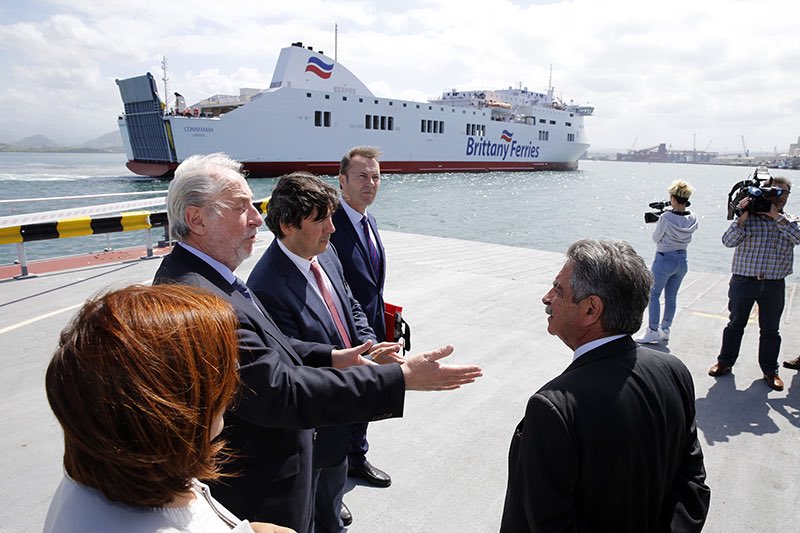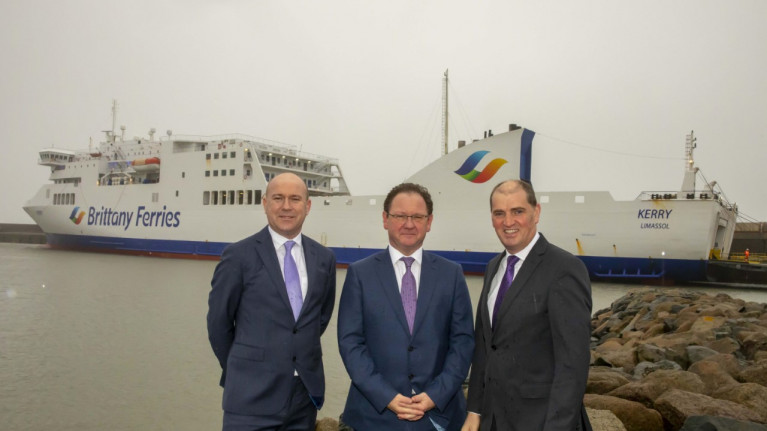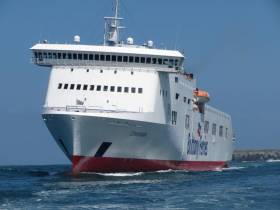Displaying items by tag: New IrelandSpain route
Brittany Ferries ropax ferry Kerry which completed a repositioning voyage to Rosslare Europort earlier today has since departed having embarked on an inaugural direct sailing to Bilbao in northern Spain.
- First Rosslare to Bilbao sailing today, Friday, 28th February
- First French rotation (to Roscoff) next month on Monday, 23rd March
- Move welcomed by Irish and Spanish hauliers
The new route out of Rosslare in Co. Wexford according to Brittany Ferries has been welcomed by hauliers given the port’s proximity to Dublin and the east coast road network. Equally hauliers operating on the European mainland have welcomed the move to Bilbao, a port more attuned to freight traffic with easier transport links into the Iberian Peninsula.
While primarily aimed at the freight market into Europe, the route will also carry holidaymakers to both Spain and France (noting new route also to Roscoff). It will be part of Brittany Ferries ‘économie’ service, offering a comfortable, no-frills voyage. Sailings will be twice-weekly and will incorporate a weekly Ireland/France rotation.
Speaking at the launch of the new route to Spain, Brittany Ferries Group Freight Director, Simon Wagstaff: “I am delighted to be here for the first Brittany Ferries sailing from Rosslare. Since we opened operations linking Ireland and Spain in 2018 we have listened carefully to feedback from freight customers, on what is predominantly a route for commercial traffic. The clear message was that a move to Rosslare would help them and us deliver a more attractive option to the UK landbridge. We now operate from two ports in Ireland, reinforcing our commitment to the country, its people and its economy.”
Glenn Carr, General Manager, Rosslare Europort added: “We are delighted to welcome Brittany Ferries’ Kerry to Rosslare Europort today. We look forward to working with Brittany Ferries to building a successful partnership to serve freight and passenger customers. The decision to introduce this service not only shows the appeal of Rosslare Europort to shipping lines, freight and tourism customers, but also is the first of what we intend to be a number of new business announcements, building on our €25 million investment plans in port facilities, infrastructure and technology".
Carr added "Rosslare Europort is Ireland’s closest port to mainland Europe, and is now the only port outside of Dublin with a Border Inspection Post facility, and will provide the quickest direct services for exports and imports to both Europe and the UK post-Brexit".
The new Rosslare to Bilbao route will open for passenger bookings online in early March but customers can now book through the Brittany Ferries reservations team by phone on 021 427 7801. Our Freight Reservations team can be contacted on +44 (0)330 159 5000.
#FerryNews - Connemara, Brittany Ferries chartered ropax completed a maiden Cork-Santander crossing this afternoon, marking the historic first arrival of an Ireland-Spain ferry service, writes Jehan Ashmore.
Under glorious blue skies, Connemara arrived into Santander Bay and docked at the Muelle del Almte with the backdrop of the Cantabrian mountains of northern Spain. The 500 passenger / 120-cabin capacity ropax can take between 80-100 cars and 100 freight trailers. The direct route is a game-changer for tourists and hauliers and notably in a looming post-Brexit environment in addition to enhancing cultural ties between Ireland and Spain.
Brittany Ferries operates Connemara on the 26-hour crossing and based on a twice weekly overnight sailings, departing Cork on Wednesdays (see yesterday's coverage) and Fridays. The return sailings from Santander are on Sundays and Thursdays. The new service has been a strategic goal for the Port of Cork Company when plans were made to establish the link since 2004 that involved discussions with other ferry operators and another port in northern Spain.

Above: Connemara arrives in Santander this afternoon with officials from Gobierno de Cantabria, the regional authority of the autonomous community. The officials stand on the ferry's ro-ro berth linkspan located on the quay of the ferry terminal (Photo: Government of Cantabria - twitter)
Among the sold-out inaugural économie 'no-frills' which only caters for motorists passengers were fans of Leinster Rugby. They are heading for the European Rugby Champions Cup final in Bilbao to be held on Saturday where they play French team Racing 92 from Paris.
Also driving off the 195 vehicle ferry onto Spanish soil were an impressive array of supercars worth millions of euro. They involved Bentleys, BMW's, McCLarens and Lamborghinis. The cavalcade of high-performance cars are to embark on a 3,000km, 10-day fundraising tour throughout Spain in aid of childrens’ charity the Bubblegum Club.
Brittany Ferries are no strangers to the Cantabrian port having established four decades ago a direct service from the port to the UK. This began with a Plymouth-Santander service in 1978.
In the same year the French ferry company launched the Cork-Roscoff route in which Connemara also carries out a single weekday round-trip service again based on the no-frills concept. The Ireland-France route taking 14 hours is also operated by flagship Pont-Aven which has sailings based on cruiseferry standards.





























































